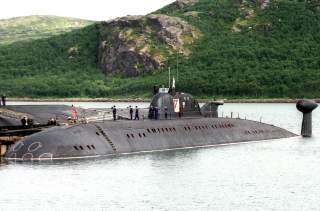The Real Reason Why Russia Sent a Bunch of Subs Into the Atlantic Back in 2019
The great game is afoot.
Key point: Moscow likes flexing its muscles to make a point. Russia wants everyone to know they are back and are a serious power.
The Russian navy in late 2019 surged a huge number of submarines into the Atlantic Ocean, prompting NATO to sortie patrol planes from Norway, Iceland and Scotland.
This first appeared in 2019 and is being reposted due to reader interest.
The result was one of the biggest concentrations in years of submarines and anti-submarine-warfare aircraft. And a stark reminder that NATO and Russian naval and air activity is returning to Cold War-levels of intensity.
The Russian navy in mid-October 2019 deployed submarines in the country’s biggest undersea exercise since the Cold War.
The eight subs, including six nuclear-powered boats, sailed from their bases in northern Russia into the cold waters of the Barents and Norwegian Seas.
At the same time, an additional two boats -- the nuclear-powered Sierra-class attack submarines Pskov and Nizhny Novgorod -- sailed into roughly the same waters for tests and training.
The 10 vessels represent around 20 percent of the Russian submarine force.
More than a dozen NATO patrol planes flew back-to-back missions in order to find and track Moscow’s submarines. Amatuer plane-spotters using commercial software kept tabs on the planes’ transponders.
It’s unclear how many NATO submarines also joined the hunt for the Russian boats.
Between Oct. 25 and Nov. 7, 2019, the NATO planes flew more than 40 missions. Six Norwegian air force P-3s, four U.S. Navy P-8s and a Canadian air force CP-140 flew from Andoya in Norway. At least one additional P-8 flew from Keflavik in Iceland. A French navy Atlantic 2 patroller staged from Prestwick airport in Scotland.
Flight-trackers followed the patrol planes as they flew hundreds of miles into the North Atlantic to fly racetrack patterns over the apparent locations of Russian submarines. The patrol planes use their radars, sonar buoys and magnetic detectors to find subs on and below the waves.
The submarine activity, and anti-submarine patrols, appeared to concentrate on the eastern side of the so-called “GIUK Gap,” the stretches of open ocean between Greenland, Iceland and the United Kingdom.
The eight vessels in the Russian exercise were practicing protecting a “bastion” of open ocean in which Russian ballistic-missile submarines can hide. “The aim of the massive operation is to get as far out to the North Atlantic as possible without being discovered by NATO,” Barents Observer noted, citing Norwegian intelligence sources speaking to news outlet NRK.
The Russian exercise seemed to highlight Moscow’s new approach to undersea warfare. While the war game reportedly was defensive in nature, the same submarines could conduct offensive operations from the same waters.
During the Cold War, Soviet submarines needed to pass through the maritime chokepoint of the GIUK Gap in order to reach the open ocean and close within striking range of NATO ports and ships. That’s not the case with newer Russian subs with their longer-range weapons.
Assuming budgets remain at their current level, in the 2020s the Russian submarine fleet could include up to 10 Yasen-class guided-missile submarines plus upgraded Kilo-, Akula-, Oscar- and Sierra-class attack submarines, for a grand total of probably around 50 vessels.
Many of the boats will carry the Russian navy’s new Kalibr land-attack cruise missile, which apparently can strike targets as far away as 1,500 miles. Kalibr “gives the Russian navy a long-range strike capability it has never before possessed,” Andrew Metrick, an analyst with the Center for Strategic and International Studies in Washington, D.C., explained in Proceedings, the professional journal of the U.S. Naval Institute.
A Yasen-class submarine could fire its 40 Kalibrs from the Russian side of the GIUK Gap and still strike strategic NATO ports in western Europe such as Bremerhaven. “This new reality cannot be addressed by focusing on the GIUK Gap,” Metrick warned.
“Russian submarines no longer have to transit the gap to have a dramatic impact on the European military balance,” Metrick explained. “Rather, they can operate from the relative safety of bastions in the Norwegian and Barents seas and strike targets across Northern and Central Europe.”
In attempting to counter the Russian subs, the United States and NATO should avoid slipping back into its own Cold War ways, experts warned. They said it takes creative thinking to understand, and counter, Russia's current undersea-warfare doctrine.
But it clearly also takes traditional aerial sub-hunting, as NATO’s October-to-November ASW surge underscored.
David Axe serves as Defense Editor of the National Interest. He is the author of the graphic novels War Fix, War Is Boring and Machete Squad. This first appeared in 2019 and is being reposted due to reader interest.
Image: Reuters

